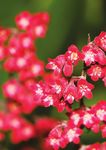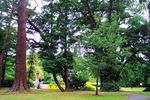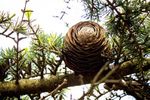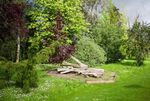Biodiversity Strategy Streatham Campus 2016-2021
←
→
Page content transcription
If your browser does not render page correctly, please read the page content below
Biodiversity Strategy
Streatham Campus 2016-2021
www.exeter.ac.uk/sustainability
The University of Exeter manages
153 hectares of land in Exeter. The
estate continues to represent a wide
range of habitats, which help support
amphibians, birds, reptiles, insects,
mammals and aquatic life.
T he habitats should not be
viewed in isolation, as
they cumulatively help form
important links and wildlife
corridors to other areas of
nearby public open space
and private land, including
woodlands and watercourses.
This makes the open spaces the University
manages an important contributor to biodiversity
in Exeter and the wider Devon area.
Our Biodiversity Strategy represents a continuing
commitment, by the University, to preserve existing
important habitats and, where the opportunity arises,
create new sustainable habitats. It forms part of a
commitment to sustainable practices for buildings and
the public realm, engaging with students, staff and the
local authority, to strike a valued balance that places
buildings in a landscape setting.Streatham Campus
Biodiversity Map
3 Innovation
Centre
Harrison
Laver
Living
Systems
Birks
Grange
Village 2
Nash
Grove
Xfi
Streatham
Reed Court
Hall
1 Forum
4
Washington
Singer
Mixed woodland
Protected site
Watercourses and
wildlife corridors
Existing site important
to species conservation
(County Wildlife site)
1 2 3 4
Site 1: Reed Hall Arboretum Site 2: Birks Bank Arboretum Site 3: Edinburgh Wild Site 4: Old Botanic Garden,
and listed historical landscape Conifer Collection Poole GateGuiding principles/priorities
W The Streatham Campus map has been annotated to indicate the priority areas for
preserving and enhancing landscape and biodiversity, as a commitment within the Estates
Strategy, considering the ongoing development of an ambitious University wishing to deliver
facilities and environments that support its values and priorities.
1 Preserve and enhance 2 Identifying specialist 4 Work plans to
existing landscapes and measures to protect incorporate
habitats vulnerable species sympathetic tree and
The following existing sites have been • P lot known badger setts on campus hedgerow management
prioritised as they have important to ensure compliance with the Badger orks will comply with the adopted
•W
landscape and habitat value, which Act. Consult ecologists regarding best arboricultural and hedgerow
shall continue to be managed for practice to avoid disturbance of setts. management principles.
species conservation:
ontinue to install bat boxes on
•C on-essential tree works will be avoided
•N
• Reed Hall Pond and buildings and landscaped areas. during the bird nesting season (approx.
Arboretum April to September).
This site is part of a listed historic ontinue to monitor bird populations
•C
landscape. It contains habitats such as on campus, with a view to preserving on-essential hedgerow maintenance
•N
standing water, mixed woodland and and enhancing habitats on campus works will be avoided during the bird
specimen plants. where red and amber list species have nesting season.
been identified.
• Birks Bank Arboretum here works have to be undertaken
•W
A tree collection with rare conifers and ontinue to develop wildflower
•C e.g. for health and safety, sight line,
an understory with naturalised bulbs. meadows and nectar highways, to access etc. trees and hedges will be
encourage pollinating insects. checked for bird nesting activity prior
• Royal Botanic Garden to implementation and nests left
Edinburgh Wild Conifer odify strimming and mowing
•M
undisturbed.
Collection regimes to maximise biodiversity,
as well as maintain access and meet
Areas of the campus where, in
association with RBGE, seeds collected aesthetic demands. 5 New and upgraded
from conifers in the wild are being planting schemes
grown and monitored to determine 3 Zero green waste • Incorporate a range of plants, trees
their adaptation for the UK climate and to landfill and shrubs that cover a wide range of
potential introduction to the commercial flowering periods, with a balanced mix
market in the UK. ontinue to seek exemption from
•C
of deciduous and evergreen species,
the Environment Agency to store
as well as plants which are native and
• Lower Hoopern Valley/ and screen green waste on campus.
adapted to the University microclimate.
Taddiforde Brook
se screened green waste on
•U The aim is to enhance habitats, to
Designated as a County Wildlife site this
campus as soil improver and mulch encourage year round wildlife activity
area is sympathetically managed to try
during landscape projects and and introduce adaptability to cope
and benefit wildlife with habitats such
improvement works. with any impact of the effects of
as semi-natural woodland, semi-natural
global warming.
grassland and a watercourse with areas
• E stablish three new locations for habitat
of both flowing and standing water.
piles, bug hotels and insect palaces each
year of the strategy.6 Watercourse management 7 Continue to review
• Continue a programme of tree pruning and non-sustainable peat use
management, to reduce excess shading and arget 0% peat use in nursery production
•T
over-nitrification from organic input around by 2017.
ponds and watercourses.
arget 60% reduction in estate management
•T
• Continue a programme of controlling exotic use of peat by 2018.
and problem aquatic weed species, to
ensure they do not dominate pond life and arget 75% use of shredded green waste
•T
have a detrimental effect on oxygen levels generated on campus as peat alternative or
in ponds. mulch by 2019.
• Continue to provide ecostrips and margins
around ponds, to provide safe areas for
8 Encourage engagement
aquatic life such as birds and amphibians. with biodiversity on
our campuses
• Introduce a phased programme of pond
management, to regularly control the build-
ork with the Students’ Guild to encourage
•W
student participation with biodiversity on
up of silt and excess organic material around
campus, including practical volunteering
the campus watercourse systems.
with project works on the estate.
ork with the Staff Association to encourage
•W
staff volunteering for biodiversity project
work on campus.
• P romote the campus outdoor areas as
a living lab for research and study.
Campus Services
Streatham Farm
Prince of Wales Road
Exeter EX4 4PX
Telephone +44 (0)1392 725533
www.exeter.ac.uk/sustainability
2016CS089You can also read



























































